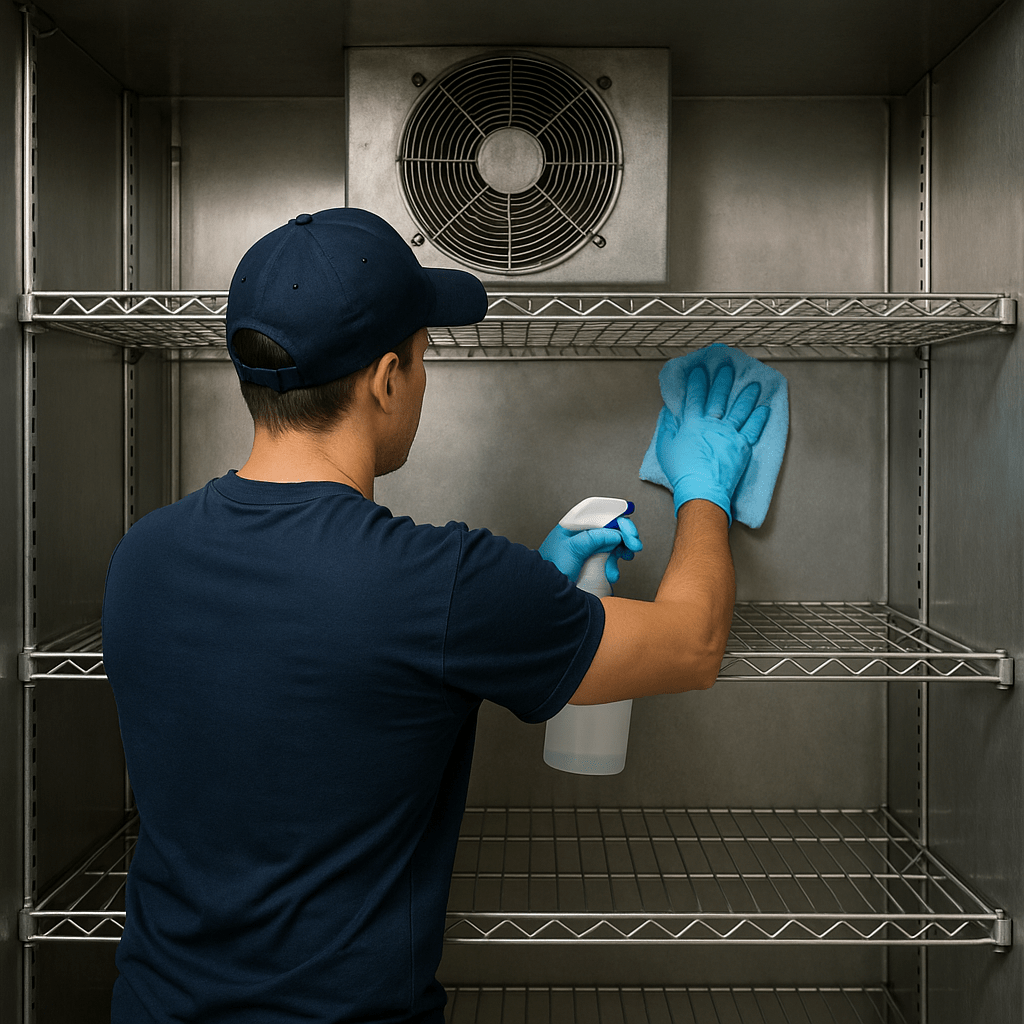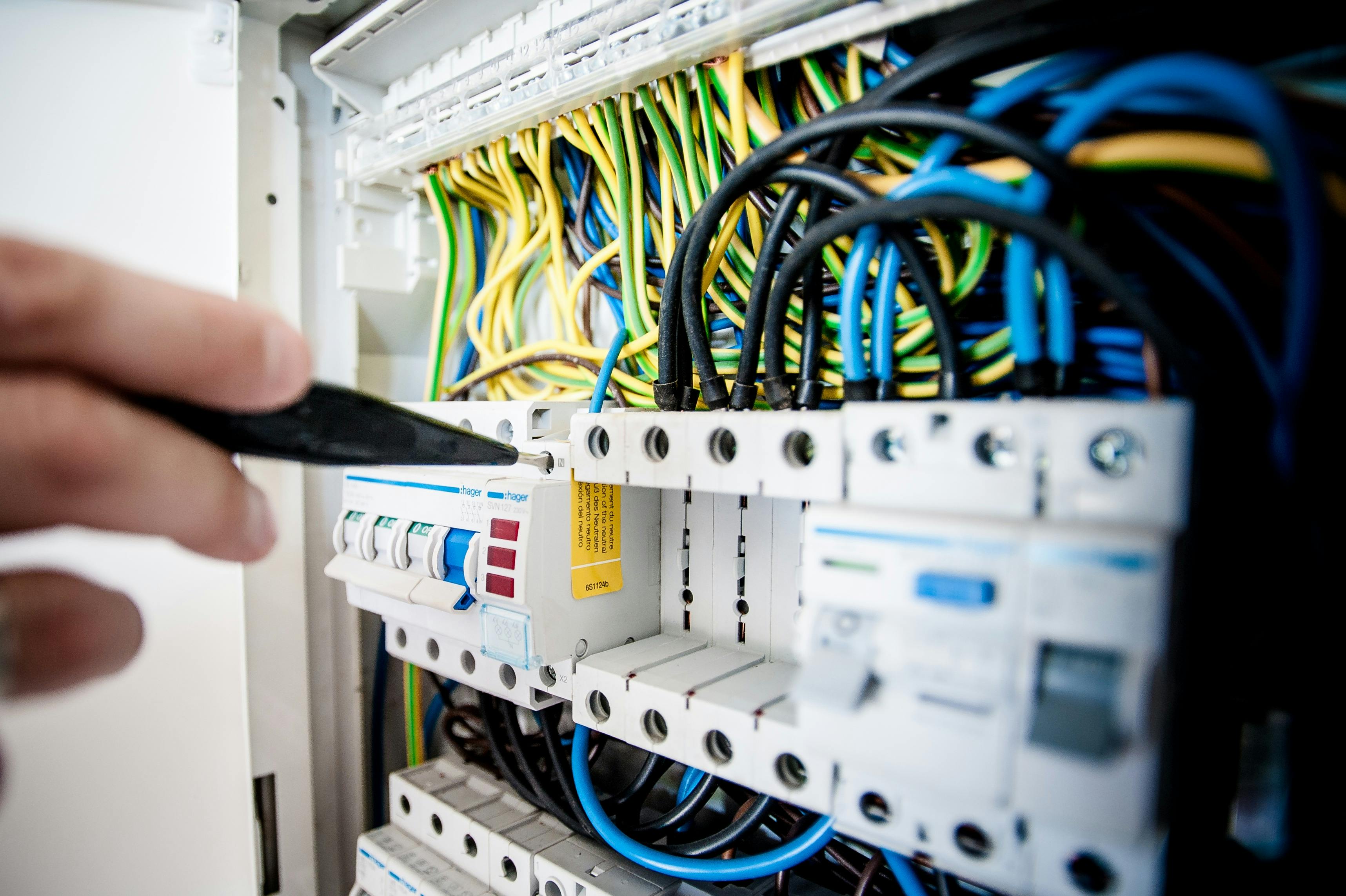Commercial Refrigeration Cleaning: What to Clean, How Often, and Who Should Do It

Commercial refrigeration cleaning is one of the most overlooked — yet essential — tasks in any professional kitchen. Whether you're running a single restaurant or managing multiple locations, keeping your refrigeration units clean is critical for both food safety and equipment performance.
While routine maintenance often gets more attention, cleaning is what keeps your coolers running efficiently day after day. Dirt, mold, and grease buildup don’t just look bad — they quietly raise temperatures, strain compressors, and increase the risk of health code violations.
This guide breaks down everything you need to know about cleaning commercial refrigeration units: how often to do it, what areas to focus on, and whether to handle it in-house or with a pro. From walk-ins and prep tables to undercounter fridges, we’ll help you build a cleaning process that protects your cold line and your bottom line.
Let’s dive in — and keep it cool. ❄️
1. Why Cleaning Commercial Refrigeration Matters
Clean refrigeration is not just about appearances — it directly impacts food safety, kitchen efficiency, and your restaurant’s compliance standing. Skipping or delaying cleaning routines can quietly lead to bigger problems than you might think.
🧫 Food Safety Comes First
Commercial refrigeration cleaning plays a vital role in preventing cross-contamination, mold growth, and bacterial spread. Spills, condensation, and food debris can become breeding grounds for harmful pathogens — especially in hard-to-reach corners and seals. A dirty fridge is a health code violation waiting to happen.
⚠️ Health Code Compliance
Health inspectors look closely at your refrigeration units. Moldy gaskets, sticky shelves, or residue in the drain pan can all lead to lost points — or worse, a failed inspection. Regular cleaning helps you stay inspection-ready at all times.
🧊 Equipment Performance
Dust and grease buildup on coils, fans, and vents can force your refrigeration system to work harder than it should. That added strain increases energy use, shortens the lifespan of your unit, and raises the risk of unexpected breakdowns. Cleaning is preventive maintenance — and a simple way to protect your investment.
👃 Odors and Off-Flavors
Leftover spills, rotting produce, and stagnant water can all contribute to unpleasant smells or flavor transfer between items. That’s a quick way to ruin both your mise en place and your customer experience.
👀 Professional Image
In open kitchens or during health inspections, the cleanliness of your refrigeration reflects the standards of your entire kitchen. A spotless fridge isn’t just about hygiene — it shows pride, discipline, and professionalism.
2. What’s Included in Commercial Refrigeration Cleaning?
A proper commercial refrigeration cleaning routine goes far beyond wiping down visible surfaces. It involves both the interior and exterior of the unit, as well as key technical components that directly affect performance and hygiene.
Let’s break down what needs to be cleaned — and how often.
🧼 Interior Cleaning
The inside of your refrigeration unit is where food is stored — and where contamination is most likely to happen. Key tasks include:
- Shelves and racks: Remove and clean thoroughly to prevent sticky buildup, spills, and cross-contamination.
- Door gaskets (seals): These rubber seals trap moisture and crumbs. If neglected, they become breeding grounds for mold.
- Interior walls and floor: Regular wipe-downs reduce grime and prevent foul odors from developing.
- Drain pans and lines: Often overlooked, but critical. If clogged, they can cause water to pool, promoting bacterial growth and even leakage.
🕒 Frequency:
- Light cleaning: Daily or weekly, depending on usage.
- Deep interior cleaning: At least once a month.
🧽 Exterior Surfaces
The outside matters, too — especially for appearance and hygiene in open kitchens. Focus areas:
- Handles and doors: High-touch points that collect grime and bacteria.
- Top and sides of units: These areas accumulate dust and grease over time — especially near cooking lines.
- Kickplates and vents: If blocked or dirty, they reduce airflow and strain the system.
🕒 Frequency:
- Quick wipe-downs: Daily.
- Full clean: Weekly.
⚙️ Technical Components (That You Can Access)
While full servicing should be handled by a pro, some parts are accessible and benefit from regular cleaning:
- Condenser coils: Dust buildup can cause overheating and inefficiency. A quick vacuum or brush every few weeks makes a big difference.
- Evaporator fans: If they’re accessible and safe to reach, gently clean any dust or debris that could reduce airflow.
🕒 Frequency:
- Light check/clean: Monthly.
- Professional inspection and deep clean: Every 3–6 months.
💧 Condensation and Drain Management
Moisture buildup in drains, trays, or inside the fridge is more than just annoying — it’s a sanitation risk. Check that:
- Drain lines are clear
- Drain pans are emptied and cleaned
- No stagnant water is pooling inside
🕒 Frequency: Weekly checks, with monthly cleaning.
3. Daily vs. Weekly vs. Deep Cleaning
Keeping your commercial refrigeration clean isn’t just about doing a deep clean once in a while. It’s about setting the right rhythm — so grime, mold, or grease never get the upper hand.
Here’s how to structure your cleaning efforts:
🧼 Daily Tasks
The goal here is simple: keep surfaces clean and safe between deeper cleans. Wipe down handles, shelves, and doors, especially around high-touch areas. Watch for spills or condensation, and make sure doors close properly. These quick checks take minutes, but they help prevent bacteria buildup and unpleasant smells.
🧽 Weekly Tasks
Every week, schedule a more thorough wipe-down. Empty and clean drawers, bins, and shelves. Sanitize internal walls, door gaskets, and drip trays. This is a good time to inspect for wear and tear or anything unusual — like ice buildup or standing water.
🧯 Monthly / Deep Cleaning
This is where things get technical — and where outsourcing often makes sense. A deep cleaning should include the condenser coils, fans, drain lines, door gaskets, and even the floor underneath or behind the unit. For walk-ins, don’t forget the ceiling and lighting fixtures. These areas often hide grease and moisture — two enemies of refrigeration efficiency.
✅ Tailor by Equipment Type
Each fridge type has its own cleaning needs:
- Reach-in refrigerators need regular door and shelf care.
- Prep tables gather food debris and spills — especially under pans.
- Walk-in coolers demand full-surface cleaning and careful drain maintenance due to their size and humidity.
4. Common Cleaning Mistakes
Even well-meaning cleaning routines can backfire if they skip the details — or worse, create new risks. When it comes to commercial refrigeration cleaning, here are the most frequent (and costly) mistakes to avoid:
❌ Skipping the Door Gaskets
The rubber gaskets around fridge doors trap food debris, moisture, and bacteria — especially in prep-heavy kitchens. Yet they’re often forgotten. Neglecting them leads to bad smells, bacterial growth, and even air leaks that strain your compressor.
❌ Cleaning with Hot Water
Using hot water might seem like the right move, but it’s a trap. The heat creates condensation, which encourages mold and can damage internal components. Always stick to cold or lukewarm, food-safe cleaning solutions designed for refrigeration units.
❌ Ignoring the Condenser
If you’re not cleaning your condenser coils, you’re asking for trouble. Dust and grease build up quickly, forcing the unit to work harder — which leads to higher energy bills, overheating, or sudden breakdowns. This should be part of any deep cleaning checklist.
❌ Using Harsh or Unsafe Products
Not all cleaning agents are fridge-safe. Some chemicals are corrosive and can damage surfaces or leave harmful residues near food. Always use food-grade, non-corrosive products designed for stainless steel and cold environments.
❌ Cleaning While the Unit Is Running
Wiping down a fridge without switching it off might save time, but it’s risky. Moisture and exposed electrical parts don’t mix well. Unplug or switch off the unit when performing deeper cleaning — especially around fans, coils, and electrical panels.
5. When to Call a Pro for Cleaning
Not every task can (or should) be handled in-house. Some situations call for expert help — both for safety and efficiency.
Professional commercial refrigeration cleaning becomes essential in the following cases:
🧼 Deep Dirt You Can’t Reach
If your fridge has layers of grease, hardened food residue, or mold that keeps coming back, it’s time to bring in the pros. They’ll have the tools — and the patience — to clean what regular wipe-downs miss.
🔧 Hard-to-Reach Components
Accessing condenser coils, drain pans, or behind the unit safely isn’t always straightforward. Trained professionals know how to disassemble, clean, and reassemble critical parts without damage.
👃 Persistent Odors
If smells linger even after a full cleaning, something’s off. It could be mold in the drainage line or spoiled food particles trapped in unreachable areas. A professional cleaning can identify and eliminate the root cause.
🏢 Multi-Site Operations
For restaurant groups or franchises, outsourcing ensures consistency across locations. A professional team can implement the same protocols, schedules, and documentation across your entire operation — without relying on individual store managers to enforce standards.
📌 Want to go a step further? Read our full article on commercial refrigeration maintenance to learn how cleaning fits into a broader preventive strategy that protects your equipment long-term.
6. How Boh Supports Commercial Refrigeration Cleaning
Keeping your refrigeration systems clean doesn’t have to mean more work for your team. Boh makes it simple to manage both one-off cleanings and recurring commercial refrigeration cleaning routines — without the usual back-and-forth.
Whether it’s a weekly wipe-down or a quarterly deep clean, we connect you with vetted professionals who know exactly how to clean commercial fridges the right way — including coils, gaskets, and drainage systems. That means fewer smells, fewer surprises, and fridges that stay compliant and reliable longer.
Because Boh also manages refrigeration maintenance, it’s easy to coordinate both cleaning and service under one roof — no need to chase multiple vendors. For restaurants on a Preventive Maintenance Plan (PMP), commercial refrigeration cleaning can be fully integrated, ensuring your equipment stays in top shape year-round.
Conclusion
Cleaning isn’t just about appearances — it’s your first line of defense for commercial refrigeration.
A fridge that’s regularly cleaned runs more efficiently, lasts longer, and keeps food safe. It also helps prevent surprise breakdowns, foul smells, and failed inspections — all things that slow your kitchen down.
✅ Build a simple, realistic routine
✅ Train your team on the daily basics
✅ Bring in pros when it goes beyond the surface
✅ Track it — so nothing slips through the cracks
It doesn’t have to be complicated. Just consistent.
FAQ: Commercial refrigeration cleaning
How often should commercial refrigerators be cleaned?
Daily for surface spills and handles, weekly for shelves and drawers, and monthly (or quarterly) for deep cleaning — including fans, coils, and drains.
Can staff clean the condenser coils?
Only if they’re trained and the unit is powered off. Otherwise, it’s safer and more effective to call a pro.
What cleaning products are safe for food equipment?
Use food-safe degreasers and disinfectants that are NSF-certified or clearly labeled for use in food environments. Avoid anything corrosive or bleach-based.
What’s the best way to eliminate odors in commercial refrigeration?
Start with a deep clean: shelves, drains, and gaskets. Persistent odors often point to hidden mold or clogs — and may require professional attention.
Does Boh handle fridge cleaning as part of a maintenance plan?
Yes. Boh can schedule both standalone cleanings and recurring fridge cleaning as part of a preventive maintenance plan — coordinated with your other kitchen services.











